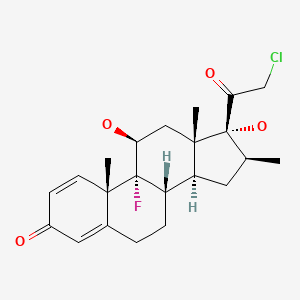Attribution Statement: LactMed is a registered trademark of the U.S. Department of Health and Human Services.
NCBI Bookshelf. A service of the National Library of Medicine, National Institutes of Health.
Drugs and Lactation Database (LactMed®) [Internet]. Bethesda (MD): National Institute of Child Health and Human Development; 2006-.
CASRN: 25122-41-2

Drug Levels and Effects
Summary of Use during Lactation
Clobetasol has not been studied during breastfeeding. Since only extensive application of the most potent corticosteroids may cause systemic effects in the mother, it is unlikely that short-term application of topical corticosteroids would pose a risk to the breastfed infant by passage into breastmilk. However, it would be prudent to use the least potent drug on the smallest area of skin possible. It is particularly important to ensure that the infant's skin does not come into direct contact with the areas of skin that have been treated. Only the lower potency corticosteroids should be used on the nipple or areola where the infant could directly ingest the drugs from the skin; clobetasol should be avoided on the nipple.[1] Only water-miscible cream or gel products should be applied to the breast because ointments may expose the infant to high levels of mineral paraffins via licking.[2] Any topical corticosteroid should be wiped off thoroughly prior to nursing if it is being applied to the breast or nipple area.
Drug Levels
Maternal Levels. Relevant published information was not found as of the revision date.
Infant Levels. Relevant published information was not found as of the revision date.
Effects in Breastfed Infants
Topical application of a corticosteroid with relatively high mineralocorticoid activity (isofluprednone acetate) to the mother's nipples resulted in prolonged QT interval, cushingoid appearance, severe hypertension, decreased growth and electrolyte abnormalities in her 2-month-old breastfed infant. The mother had used the cream since birth for painful nipples.[3]
A woman who was nursing (extent not stated) her newborn infant was treated for pemphigus with oral prednisolone 25 mg daily, with the dosage increased over 2 weeks to 60 mg daily. She was also taking cetirizine 10 mg daily and topical betamethasone 0.1% twice daily to the lesions. Because of a poor response, the betamethasone was changed to clobetasol propionate ointment 0.05%. She continued breastfeeding throughout treatment and her infant was developing normally at 8 weeks of age and beyond.[4]
Effects on Lactation and Breastmilk
Relevant published information was not found as of the revision date.
Alternate Drugs to Consider
(Topical) Hydrocortisone, Topical, Triamcinolone, Topical
References
- 1.
- Barrett ME, Heller MM, Fullerton Stone H, et al. Dermatoses of the breast in lactation. Dermatol Ther. 2013;26:331–6. [PubMed: 23914890]
- 2.
- Noti A, Grob K, Biedermann M, et al. Exposure of babies to C(15)-C(45) mineral paraffins from human milk and breast salves. Regul Toxicol Pharmacol. 2003;38:317–25. [PubMed: 14623482]
- 3.
- De Stefano P, Bongo IG, Borgna-Pignatti C, et al. Factitious hypertension with mineralocorticoid excess in an infant. Helv Paediatr Acta. 1983;38:185–9. [PubMed: 6874387]
- 4.
- Westermann L, Hugel R, Meier M, et al. Glucocorticosteroid-resistant pemphigoid gestationis: successful treatment with adjuvant immunoadsorption. J Dermatol. 2012;39:168–71. [PubMed: 22379622]
Substance Identification
Substance Name
Clobetasol
CAS Registry Number
25122-41-2
Disclaimer: Information presented in this database is not meant as a substitute for professional judgment. You should consult your healthcare provider for breastfeeding advice related to your particular situation. The U.S. government does not warrant or assume any liability or responsibility for the accuracy or completeness of the information on this Site.
- User and Medical Advice Disclaimer
- Drugs and Lactation Database (LactMed) - Record Format
- LactMed - Database Creation and Peer Review Process
- Fact Sheet. Drugs and Lactation Database (LactMed)
- Drugs and Lactation Database (LactMed) - Glossary
- LactMed Selected References
- Drugs and Lactation Database (LactMed) - About Dietary Supplements
- Breastfeeding Links
- PubChem SubstanceRelated PubChem Substances
- PubMedLinks to PubMed
- Review Diflorasone.[Drugs and Lactation Database (...]Review Diflorasone.. Drugs and Lactation Database (LactMed®). 2006
- Review Desoximetasone.[Drugs and Lactation Database (...]Review Desoximetasone.. Drugs and Lactation Database (LactMed®). 2006
- Review Halobetasol.[Drugs and Lactation Database (...]Review Halobetasol.. Drugs and Lactation Database (LactMed®). 2006
- Review Amcinonide.[Drugs and Lactation Database (...]Review Amcinonide.. Drugs and Lactation Database (LactMed®). 2006
- Review Betamethasone, Topical.[Drugs and Lactation Database (...]Review Betamethasone, Topical.. Drugs and Lactation Database (LactMed®). 2006
- Clobetasol - Drugs and Lactation Database (LactMed®)Clobetasol - Drugs and Lactation Database (LactMed®)
Your browsing activity is empty.
Activity recording is turned off.
See more...
